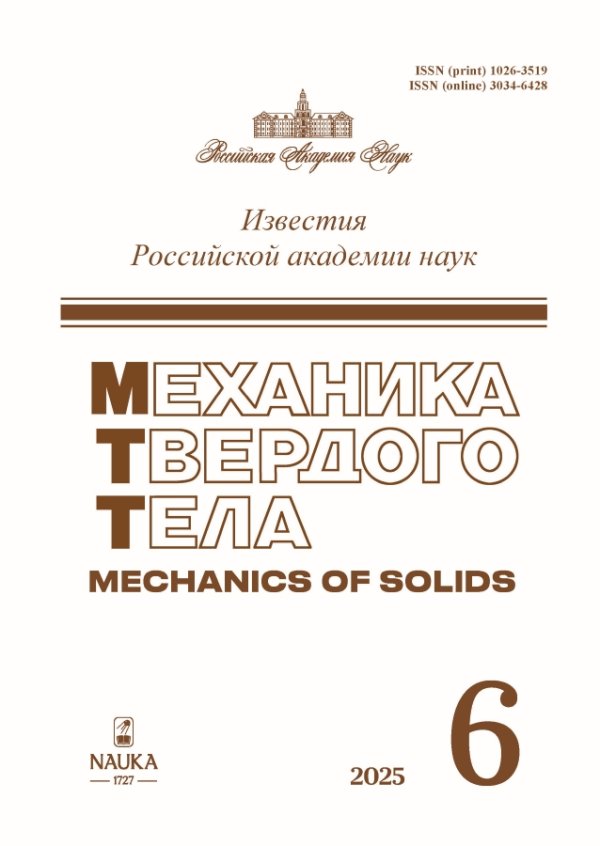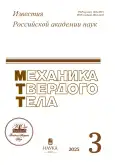ON THE CAUCHY STRAIN TENSOR, COMPATIBILITY CONDITIONS, AND DEFINING EQUATIONS OF AN ELASTIC MEDIUM
- Authors: Ostrosablin N.I1
-
Affiliations:
- Lavrent’ev Institute of Hydrodynamics, Siberian branch, RAS
- Issue: No 3 (2025)
- Pages: 207-228
- Section: Articles
- URL: https://journal-vniispk.ru/1026-3519/article/view/304230
- DOI: https://doi.org/10.31857/S1026351925030116
- EDN: https://elibrary.ru/baweml
- ID: 304230
Cite item
Abstract
Using the example of four-dimensional equilibrium equations for kinetic stresses in Eulerian rectangular coordinates, it is shown that the operator of the four-dimensional Cauchy strain tensor is conjugate (transposed) to the operator of the equilibrium equations. The same connection between the operators of the equilibrium equations and the Cauchy strain tensor also holds in the three-dimensional case. Three variants of the derivation of the conditions for the compatibility of Cauchy deformations are given. In the four-dimensional case, there are 21 compatibility conditions, and in the three-dimensional case, there are six Saint-Venant compatibility conditions. It is shown that the Cauchy strain tensor, both in Eulerian and Lagrangian variables, completely determines the deformed state of a continuous medium. At the same time, no restrictions on the amount of displacements, deformations or rotations are required. The Lagrange-Green and Euler-Almancy tensors, the so-called large or nite deformations, and the displacements are expressed using Cesaro formulas in terms of the Cauchy strain tensor. The de ning equations of an elastic continuous medium relate the Cauchy true stress tensor and the Cauchy strain tensor one to another. Using proper bases in the spaces of symmetric stress and strain tensors, the de ning relations can be written as six separate independent equations containing functions of only one argument. For continuous media with crystallographic symmetries, we can use the bases obtained on the basis of the generalized Hooke’s law.
About the authors
N. I Ostrosablin
Lavrent’ev Institute of Hydrodynamics, Siberian branch, RAS
Author for correspondence.
Email: o.n.ii@yandex.ru
References
- Prager W. Einfuhrung in die Kontinuumsmechanik. Birkhauser Verlag. Basel und Stutgart, 1961.
- Gol’denblat I.I. Nonlinear problems in elasticity theory. M.: Nauka, 1969, 366 p. [In Russian].
- Lurie A.I. Theory of elasticity. Springer Science; Business Media, 2010.
- Lurie A.I. Nonlinear theory of elasticity. M.: Nauka, 1980. 512 p. [In Russian].
- Pobedrya B.E. On the relations of geometric and physical nonlinearity in the theory of elasticity and the meaning of the vector of movements // Mechanics. Proceedings of National Academy of Sciences of Armenia, 1987. V. 40. № 4. P. 15–26 [In Russian].
- Chernykh K.F., Litvinenkova Z.N. Large elastic deformations theory. Leningrad: Izdatel’stvo Leningradskogo universiteta, 1988. 254 p. [In Russian].
- Ciarlet P.G. Mathematical Elasticity. V. 1. Three Dimensional Elasticity. North Holland, 1988.
- Korobeynikov S.N. Nonlinear deformation of solid bodies. Novosibirsk: Izdatel’stvo SO RAN, 2000. 262 p. [In Russian].
- Markin A.A., Sokolova M.Yu. Thermal mechanic of elastoplastic deformation. M.: Fizmatlit, 2013. 320 p. [In Russian].
- Brovko G.L. Constitutive relations of continuum mechanics. M.: Nauka, 2017. 432 p. [In Russian].
- Rogovoy A.A. [Formalized approach to construction of the deformed solid body. Part 1. Basic equations of continuous media mechanics. Moscow, Izhevsk: Institute of Computer Research, 2021. 286 p. [In Russian].
- Ostrosablin N.I. Compatibility conditions of small deformations and stress functions // J. Appl. Mech. Tech. Phys. 1997. V. 38. № 5. P. 774–783. https://doi.org/10.1007/BF02467892
- Ostrosablin N.I. On Beltrami–Michell equations and Saint-Venant operator // Dinamika sploshnoy sredy. 2000. V. 116. P. 211–217 [In Russian].
- Ostrosablin N.I. On compatibility conditions of small deformations and stress functions // Vestnik Novosibirskogo gosudarstvennogo universiteta. Seriya Matematika, mekhanika, informatika. 2001. V. 1. № 1. P. 67–77 [In Russian].
- Pobedrya B.E. Static problem in stresses // Vestnik Moskov. Univ. Ser. 1. Mat. Mekh. 2003. № 3. P. 61–67 [In Russian].
- Nikabadze M.U. An eigenvalue problem for tensors used in mechanics and the number of independent Saint-Venant strain compatibility conditions // Moscow Univ. Mech. Bull. 2017. V. 72. № 3. P. 66–69. https://doi.org/10.3103/S0027133017030037
- Truesdell C. Invariant and complete stress functions for general continua // Arch. Rational. Mech. Anal. 1959. V. 4. № 1. P. 1–29.
- Kilchevsky N.A. Continual systems mechanics // Izbrannye trudy. Kiev: Naukova dumka, 1984. 430 p. [In Russian].
- Kilchevskaya E.N., Kilchevsky N.A. Functions of kinetic stresses and the geometry of space in a deformed continuum // Mekhanika sploshnoy sredy i rodstvennye problemy analiza. M.: Nauka. 1972. P. 243–250 [In Russian].
- Chernyshev G.N. Mutual generalization of elastic and gravitational eld equations on the basis of solid mechanics // Mech. Solids. 2002. V. 37. № 2. P. 70–81.
- Chernyshev G.N. Elasticity, gravity, electrodynamics. M.: Nauka, 2003. 144 p. [In Russian].
- Ostrosablin N.I. Functions of kinetic stresses in the mechanics of continuous media // Dinamika sploshnoy sredy. 2007. V. 125. P. 76–116 [In Russian].
- Fedorov L.V. Solution of the Dynamic Problem of the Linear Theory of Elasticity // Mech. Solids. 2018. V. 53. P. 609–614. https://doi.org/10.3103/S002565441806002X
- Rychlewski J. On Hooke’s law // J. Appl. Math. Mech. 1984. V. 48. № 3. P. 303–314. https://doi.org/10.1016/0021-8928(84)90137-0
- Ostrosablin N.I. Functional relation between two symmetric second-rank tensors // J. Appl. Mech. Tech. Phys. 2007. V. 48. P. 734–736. https://doi.org/10.1007/s10808-007-0094-8
- Annin B.D., Ostrosablin N.I. Anisotropy of elastic properties of materials // J. Appl. Mech. Tech. Phys. 2008. V. 49. P. 998–1014. https://doi.org/10.1007/s10808-008-0124-1
- Duishenaliyev T.B., Zhakypbekov A.B., Chynybayev M.K. On the measures of deformation // Chislennye metody resheniya zadach teorii uprugosti i plastichnosti: Trudy 19 Vserossiyskoy konferentsii, Biysk. Novosibirsk: Parallel’. 2005. P. 121–126 [In Russian].
- Duishenaliyev T.B. Nonclassical decisions of the mechanics of the deformable body. M.: Izdatel’stvo MEI, 2017. 400 p. [In Russian].
- Sedov L.I. Mechanics of continuous media. World Scientic, 1997. V. 1.
- Hahn H.G. Elastizitatstheorie. Grundlagen der linearen Theorie und Anwendungen auf eindimensionale, ebene und raumliche Probleme. B.G. Teubner. Stuttgart, 1985.
- Konovalov A.N., Sorokin S.B. The structure of equations of the elasticity theory. Static problem. Novosibirsk, 1986 (Preprint. № 665). 26 p. [In Russian].
- Georgievskii D.V. Selected tasks of continuous mechanics. M.: Lenand, 2018. 560 p. [In Russian].
- Georgievskii D.V., Pobedrya B.E. The number of independent compatibility equations in the mechanics of deformable solids // J. Appl. Math. Mech. 2004. V. 68. № 6. P. 941–946. https://doi.org/10.1016/j.jappmathmech.2004.11.015
- Ostrosablin N.I. A Parametrization of the General Lorentz Group // J. Appl. Ind. Math. 2020. V. 14. P. 743–753. https://doi.org/10.1134/S1990478920040122
- Ivlev D.D. To the theory of di erential correspondence in the mechanics of the continuous environment // Izvestiya Inzhenerno-tekhnologicheskoy Akademii Chuvashskoy respubliki, 1996. № 2. P. 5–7 [In Russian].
- Ostrosablin N.I. Elasticity eigenvalues and eigenvectors for the materials of crystallographic singonium // Dinamika sploshnoy sredy. 1986. V. 75. P. 113–125 [In Russian].
- Ostrosablin N.I. Symmetry classes of the anisotropy tensors of quasielastic materials and a generalized Kelvin approach // J. Appl. Mech. Tech. Phys. 2017. V. 58. P. 469488. https://doi.org/10.1134/S0021894417030129
- Ishlinkii A.Yu. Euler description of deformation of one isotropic medium. Applied tasks of mechanics. Part. 1. Mechanics of viscoplastic and not quite elastic bodies. M.: Nauka, 1986. P. 333–336 [In Russian].
- Vasiliev V.V., Fedorov L.V. Analogy between the equations of elasticity and the general theory of relativity // Mech. Solids. 2021. V. 56. P. 404–413. https://doi.org/10.3103/S0025654421030134
- Vasil’ev V.V., Fedorov L.V. Stress functions in elasticity theory // Mech. Solids. 2022. V. 57. P. 770–778. https://doi.org/10.3103/S0025654422040197
- Lurie S., Belov P. Compatibility equations and stress functions in elasticity theory // Mech. Solids. 2022. V. 57. P. 779–791. https://doi.org/10.3103/S0025654422040136
- Vasiliev V.V., Fedorov L.V. Principal problems of relativistic mechanics of solids // Mech. Solids. 2023. V. 58. P. 2034–2042. https://doi.org/10.3103/S0025654423700231
- Stippes M. A remark on compatibility of strain // ZAMP. 1970. V. 21. № 6. P. 1081–1083.
Supplementary files










